
Hatun Willakuy
Abbreviated Version of the Final Report of the Peruvian Truth and Reconciliation Commission

Abbreviated Version of the Final Report of the Peruvian Truth and Reconciliation Commission
Hatun Willakuy is a Quechua expression meaning the great story, signifying the enormity of the events recounted in the abbreviated version of the Final Report of the Peruvian Truth and Reconciliation Commission. Before the commission, Peru had never conducted such a comprehensive examination of violence, abuse of power, or injustice.

The 10-year anniversary edition of Hatun Willakuy, presented here, summarizes the results of Peru’s two-year inquiry that mobilized over 400 experts and researchers across the country, investigating crimes and human rights violations committed during a 20-year internal armed conflict (1980-2000) — as well as the underlying causes and enduring consequences of that violence. Gathering nearly 17,000 testimonies from people who had suffered or witnessed human rights violations, the commission worked to recover that terrible history by listening to the victims who, during those years, had never had a chance to be heard or to demand their rights.
The contributions of the Peruvian truth commission to justice and reparations, as well as its impact on national debates in Peru, are significant. The Peruvian experience also has influenced the field of transitional justice, as practitioners around the world have studied it, seeking inspiration and practical ideas for the concrete challenges they face in their various contexts.
The Peruvian commission’s nine-volume Final Report, released on August 28, 2003, stands out as one of the strongest and most complete reports in the now-robust practice of establishing truth commissions in the wake of conflict or authoritarian rule.
We invite you to read in these pages the story of the violence perpetrated in Peru and to learn about the country’s quest for justice and truth. By examining the report, human rights advocates, experts, and victims groups may also be able to gauge some of the potential that a truth commission holds to contribute to human rights and consolidate the rule of law. We invite you to understand the report in terms of its deep moral imperative. Salomón Lerner Febres, the former president of the Truth and Reconciliation Commission, has said, “The constant discovery and discussion of our various endeavors, of our diverse efforts to shed light on a terrible past, is a way of keeping the sense of urgency, the sense of grieving that victims experience each and every day.”
The Tragedy and Those Responsible for It
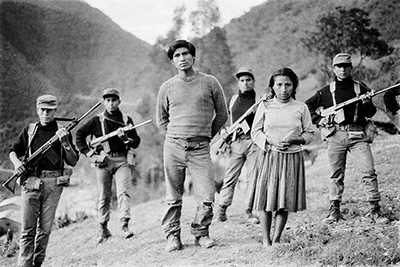
In Lar Mar, Ayacucho, in June 1985, soldiers stand with Ramon Laura Yauly and his wife, Concepcion Lahuana, who said they had been forced to join Shining Path against their will. (Abilio Arroyo / Revista Caretas)
From 1980 to 2000, Peru was rocked by an internal armed conflict that saw violence committed against civilians on an unprecedented scale. The Truth and Reconciliation Commission estimated that more than 69,000 Peruvians were lost during those two decades, either killed or forcibly disappeared by subversive groups or government forces.
The conflict was started in 1980 by the Shining Path, a Maoist group that waged war against the Peruvian government just as the country was beginning a transition from a military dictatorship to democracy. The group’s strategy, starting in the impoverished rural region of Ayacucho, employed extreme aggression and terror against Peruvian civilians.
As police action seemed ineffective against the subversive threat, in 1983 the government put the armed forces in charge of the conflict, with scarce if any civilian control. The result was a noticeable rise in violence against civilians committed by the military, which managed to merely displace the Shining Path from its original sanctuaries into other areas. Only in 1992, when Abimael Guzmán Reinoso, the Shining Path’s leader, was arrested by police detectives in Peru’s capital of Lima, did the group fall into disarray.
Number of deaths and disappearances reported to the CVR, by department where events occurred
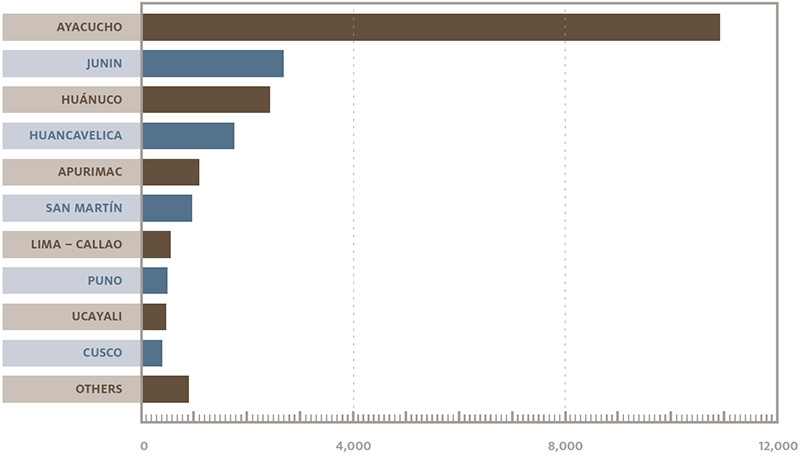
As the commission’s Final Report clearly describes, the conflict did not affect all Peruvians in the same way. Three out of four victims were peasant men and women who spoke Quechua as their native language. The majority of victims who were killed or tortured by subversives groups or the state lived in the poor highlands and jungle regions, far from the capital and other centers of power. Many survivors reported feeling that what happened in their towns and to their families didn’t seem to matter to the rest of country.
“When shown on a map of Peru, the intensity of the violence appears like a dark stain that spreads throughout the highlands and jungle regions in the central part of the country. The greatest number of victims was recorded in these areas.”
Through its investigations, the commission exposed such an extensive pattern of human rights violations that it would have be impossible for a few individuals operating outside the rules of engagement to have committed. On the contrary, the commission found that both the Shining Path and the government followed strategies that included committing atrocities.
Read the full text of Chapter 1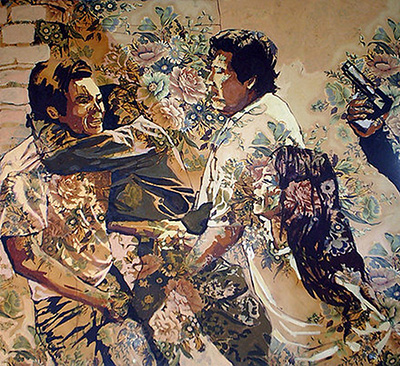
“La detención eterna III,” by Mauricio Delgado Castillo (All rights reserved)
The Shining Path
By the light of burning ballot boxes, the “Communist Party of Peru-Shining Path,” led by Abimael Guzmán Reinoso, launched a war on the Peruvian state in 1980, as the country had just held its first free elections after a 12-year military dictatorship. The Shining Path was open about its willingness to inflict death and the most extreme forms of cruelty as tools to achieve its goal, the total annihilation of existing political structures.
The Shining Path’s ideology, encapsulated in so-called “Gonzalo Thought,” was deeply polarizing. It considered all institutions or social groups outside of its control to be its enemies, thereby turning them into military targets.
Persons who held political posts or leadership roles in their communities were the Shining Path’s most visible victims, including elected representatives, traditional authorities, civil society leaders, business people, and religious men and women anywhere in the electoral spectrum were considered targets for the organization’s violence.
“We are a rising torrent at which they will launch fire, stones, and mud; but our power is great. We turn everything into our fire, the black fire will become red, and red is the light.”
The political work of marshaling support led the Shining Path to recruit heavily among young people of peasant ancestry, principally in Ayacucho, who were frustrated by the scant economic opportunities available to them in their communities. When it was unable to attract young supporters, the Shining Path used forced recruitment.
But in the face of unimaginable horror, oppressed peasants formed enclaves of resistance that chipped away at the Shining Path’s presence in their communities and prepared the ground for the organization’s eventual defeat.
Túpac Amaru Revolutionary Movement
The Túpac Amaru Revolutionary Movement (MRTA) formally launched its armed actions in 1984, presenting itself as part of the Peruvian left and explicitly distancing itself from the Shining Path. Its militants wore uniforms, lived in camps, and took credit for their actions.
The MRTA’s military strategy combined urban armed agitation with ambushes and the organization of armed military columns in the countryside. The organization faced serious financial challenges that led it to engage in cruel tactics, like kidnapping, which in several cases resulted in death.
Victims of MRTA assassinations included a leader of the Asháninka indigenous people for alleged actions against leftist guerrillas in the 1960s; retired government employees with no links to the administration in power at the time; business people; and persons whom the MRTA considered “bad influences,” such as gay men and transsexuals. As the organization failed to make strategic progress, it became involved in fractious debates, which devolved into internal assassinations.
Additionally, MRTA’s efforts to control fronts in rural areas inevitably led it into confrontations with the Shining Path, which complicated the conflict even further, creating new risks for the civilian population and increasing the number of victims.
While MRTA’s responsibility for fatalities is proportionately low in relation to the Shining Path, its armed activity undeniably increased the suffering of the Peruvian people, added to the number of human rights violations, and further weakened democratic institutions in Peru.
Read the full text of Chapter 2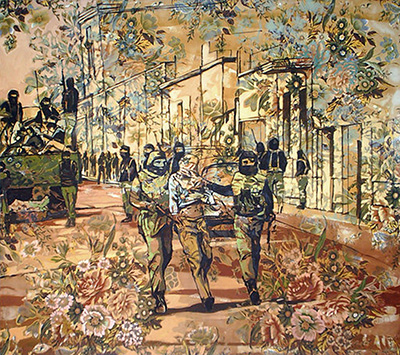
“La detención eterna I,” by Mauricio Delgado Castillo (All rights reserved)
Until the late 1980s, neither the government nor the military had developed a holistic strategy to deal with the insurgency or the root causes of the conflict.
Civilian governments —under Fernando Belaunde Terry and Alan García Pérez— mostly accepted the militarization of the conflict and gave up their constitutionally mandated role of command and control of the armed forces, allowing the armed forces to take charge of the counter-insurgency, without questioning their methods.
While it was legal for Peru’s elected governments to fight the armed groups, the commission found that it did so without taking necessary precautions to prevent the military from trampling on the fundamental rights of citizens.
Perhaps surprisingly, the most intense periods of conflict, when the majority of victims died and state agents committed the most human rights violations, occurred under democratically elected civilian governments. For long periods of time the civilian authorities ignored accusations of human rights violations committed by security forces. In many cases, the authorities guaranteed and helped to facilitate impunity for the people responsible for violations.
There was a glimmer of hope for better human rights protections in 1985, when the new president, García, showed some willingness to address abuses by the armed forces. But that period ended with a prison massacre in June 1986 against hundreds of inmates being held as members of the Shining Path.
Percentage of national territory under a state of emergency, by year
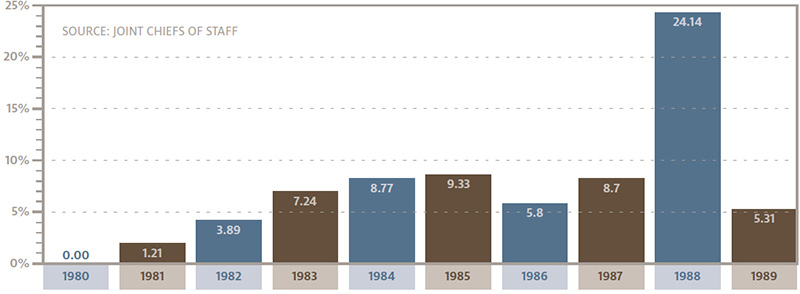
“The decision to involve the armed forces in the anti-subversive effort was made without taking the necessary precautions to protect the rights of the population.”
For long periods of the conflict, large parts of the population — especially those in Andean, rural Peru — lived under a state of emergency and military authority, or else under subversive threat, without protections for their basic rights.
The judicial system largely did not fulfill its obligation to effectively prosecute those responsible for committing human rights violations. In the vast majority of human rights cases, the Supreme Court ceded jurisdiction to military courts, accepting the theory that abuses such as torture, enforced disappearance, and extrajudicial execution were “committed in the line of duty.” Once in the military courts, these cases were usually dropped. In the handful of cases that went to trial, sentences were almost always lenient.
Read the full text of Chapter 3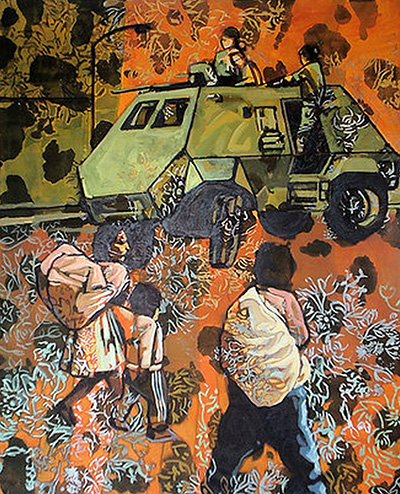
"No teníamos culpa de nada… ¿o si?” by Mauricio Delgado Castillo (All rights reserved)
In the rural areas where the Shining Path operated, the security forces pursued a strategy of widespread and indiscriminate repression to eliminate presumed Shining Path militants. This in part derived from racism against the local indigenous people who were caught in the crossfire between the military and the subversive groups.
A power struggle between the police and military over operational control also hampered the state’s ability to respond to the violence.
A large percentage of extrajudicial executions, enforced disappearances, torture, and massacres reported to the Truth and Reconciliation Commission were concentrated in the first stage of the conflict, between 1983 and 1984, when the armed forces were given control over anti-subversive efforts in the department of Ayacucho. The Shining Path also committed some of its worst atrocities during this period. Members of the security forces hit hard at certain segments of the population, such as the young, peasants, and students, repressing persons they presumed to be collaborating with the Shining Path. In many cases, they attacked entire families and communities to show peasants the high cost they would pay if they appeared to support the subversive groups.
Impact of conducts used by state agents against presumed members of subversion, by year (each line represents 6% of cases reported to the CVR)
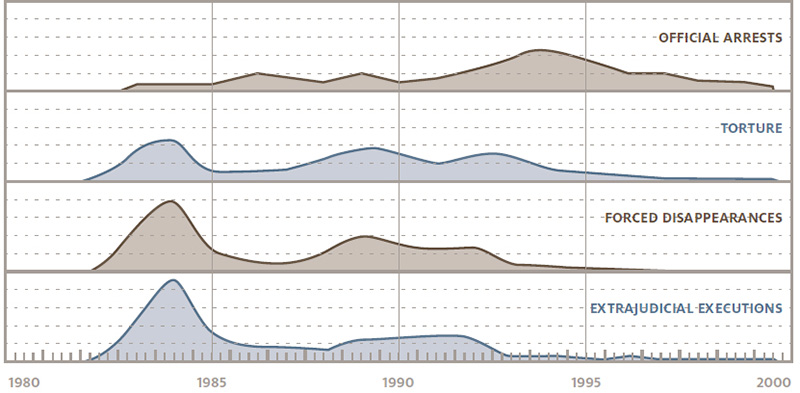
“In Peru, the predominance of special operations during the conflict led to the development of a certain type of political-military power that conspired against democracy and, finally, subjugated it.”
Of deaths and disappearances reported to the commission, state agents, the armed forces, police, self-defense patrols, and paramilitary groups were responsible for 37 percent. Of these, members of the armed forces were responsible for more than 75 percent.
Heavy-handed security policies, combined with the emergency law and a “guardian” role for the military enshrined in the 1979 Constitution, eroded the civilian control of the state.
Members of self-defense committees, acting under the control of or in acquiescence to state agents, also committed a significant number of human rights abuses. This was also true of death squads operating under the control of high government officials.
Read the full text of Chapter 4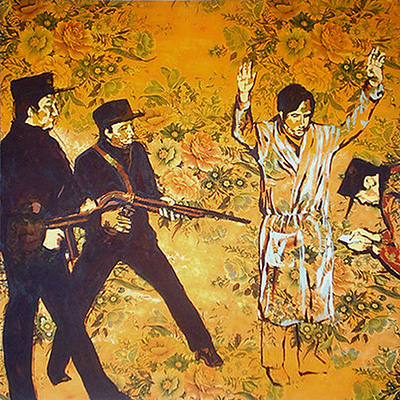
“La detención eterna II,” by Mauricio Delgado Castillo (All rights reserved)
In 1990, Alberto Fujimori, an academic-turned-politician, stunned Peru by winning the presidency. The son of Japanese immigrants, Fujimori was seen as an outsider who could tackle Peru’s economic woes, rampant inflation, and the emboldened insurgency. But without a solid party in congress or political experience, Fujimori established alliances with the military.
With the help of Vladimiro Montesinos, an adviser without any formal role in the government but enormous power as the head of the National Intelligence Service, Fujimori was able to build a political base through a mixture of populist appeal, intimidation, corruption of officials, and bribing media owners.
On April 5, 1992, Fujimori, in complicity with the Army, staged a coup d’état, declaring emergency law, dissolving Congress, capturing the judiciary, and using a massive propaganda campaign to delegitimize democratic institutions in favor of personalistic rule. A new constitution was enacted that further consolidated presidential power. With the security forces emboldened and free from civilian accountability, abuses escalated.
In the summer of 1992 security forces conducted raids at the Enrique Guzmán y Valle National Education University, known as “La Cantuta,” which resulted in the enforced disappearance of nine students and a professor. In other universities, many students accused of links with the armed groups were tortured, arbitrarily executed, or disappeared. Impunity for these and other crimes was sealed in 1995 with laws granting amnesty and forbidding the investigation of alleged state abuses committed in the course of counter-insurgent action.
“The CVR considers the amnesty law . . . a disgrace.”
The coup d’etat was legitimated as a supposed tool to facilitate a victory over the Shining Path under military leadership. However, it was an elite police unit that ultimately captured the Shining Path’s leader, Guzmán, in a safe house in Lima on September 12, 1992. Once arrested, Guzmán and his closest followers, who had previously rejected all dialogue with the elected governments of the 1980s, began conversations (that they believed were serious peace negotiations) with the Fujimori regime. As a result, Guzmán capitulated and called on his followers to give up military struggle.
The commission found that despite the capture of Guzmán and the collapse of the Shining Path, the Fujimori administration continued to use the perceived threat of armed groups as a tool to incite fear in the general population and maintain political control.
Read the full text of Chapter 5The Legacy of the Conflict and the Way to Peace
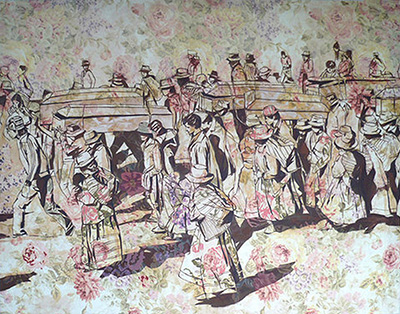
“Instantes eternos y repetibles,” by Mauricio Delgado Castillo (All rights reserved)
The commission found that the Shining Path’s decision to wage war against the state was the immediate cause of the conflict. Although the Shining Path initially tried to engage the support of impoverished peasants in its uprising, their conducts quickly moved to a campaign of terror, using authoritarian methods to control the civilian population and committing calculated acts of provocation that to cause disproportionate responses against civilians from the state.
According to the commission, several factors made Peru ripe for violence. Key among these was the gross inequality between people living in urban and rural areas, which was rooted in the historic exploitation of rural and indigenous communities. Endemic discrimination in Peruvian society fueled grievances in the rural regions and provided few instruments to resolve conflicts peacefully.
Percentage of deaths and disappearances reported to the CVR, according to the poverty ranking of the zone where events occurred
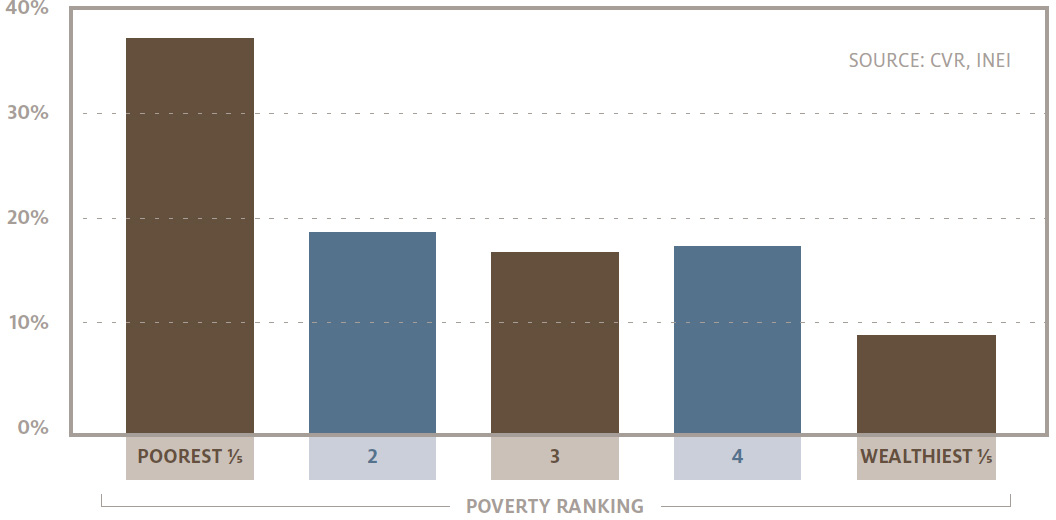
A long history of authoritarian rule nationally and locally had impeded democratic mechanisms from taking hold in the country. The rule of law was unknown in large swaths of Peru. A recent military dictatorship (1968-1980) had induced deep social transformations, but had prevented democratic governance and politics. As a result, when a transition to democracy took place in 1980, the political parties were unable to fulfill their role, and the power vacuum left in some Andean regions was readily filled by the Shining Path.
The severity of the violence was directly influenced by the duration of the conflict and the strategies employed by the subversive groups and the military. State security forces used heavy-handed tactics to crush resistance in rural and indigenous communities. While harboring scorn for the indigenous, the Shining Path was all too willing to maximize casualties to achieve its goals, as demonstrated by Guzman’s vision that the revolution would be won through a heavy “quota” of blood.
Read the full text of Chapter 6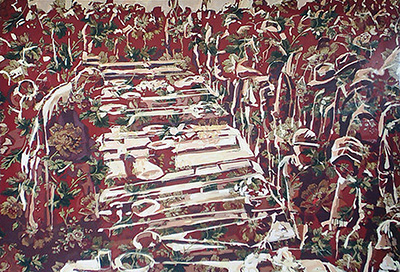
"Muchos del pueblo han muerto,” by Mauricio Delgado Castillo (All rights reserved)
The internal armed conflict caused profound, immeasurable harm to thousands of Peruvians.
The Truth and Reconciliation Commission identified three main consequences of the violence:
“To Lima, to Ica . . . They scattered, like when mother quail take flight and scatter. We scattered like quail, here and there. We suffered so much.”
The profound damages suffered socially and individually, it argued, must be met with concerted democratic action, seeking integral reparations for the victims and their relatives, rebuilding democratic institutions, and supporting integral development.
Read the full text of Chapter 7The commission paid particular attention to the issue of enforced disappearances, identifying thousands of presumed sites of hidden graves and recommending that a specialized plan be formulated to determine the fate and whereabouts of the disappeared.
The commission proposed a vision of national reconciliation focused on building a new relationship between citizens and the state, based on respect for human rights and civic trust. The commission did not propose mechanisms of reconciliation that would hinder the role of criminal justice, truth, or reparations to victims.
While the commission acknowledged that under democratically elected governments many members of political parties and members of the security forces had defended the rule of law, it also criticized harshly the successive government administrations and security forces for conducting massive human rights violations during the conflict. It also found that several institutions, including some Catholic dioceses, had failed to engage themselves more actively in the protection of human rights, contributing to the defenselessness of the civilian population.
The commission enumerated the many abuses committed by the armed groups, and called the Shining Path a force with a genocidal potential.
Read the full text of Chapter 8 Read the full text of the General ConclusionsFor more on artist Mauricio Delgado Castillo, whose paintings adorn the 10th-anniversary edition of Hatun Willakuy and help to illustrate the conflict and its consequences, visit the artist’s website.
View a collection of photos from the “Yuyunapaq (To Remember)” exhibition, organized by the Truth and Reconciliation Commission.
Ten years after the final report of the Peru's Truth and Reconciliation Commission, Peruvians reflect on how the Commission has impacted truth and justice: in their lives and in their country. Read ICTJ's in-depth story Peru's Painful Mirror.
The 2003 Spanish edition of Hatun Willakuy can be downloaded here.
Concept and direction: International Center for Transitional Justice
Design and development: Aten Design Group
Text: Meredith Barges and Sharif Hassanein
Images: Mauricio Delgado Castillo and Abilio Arroyo/Revista Caretas
Coordination: Marta Martínez